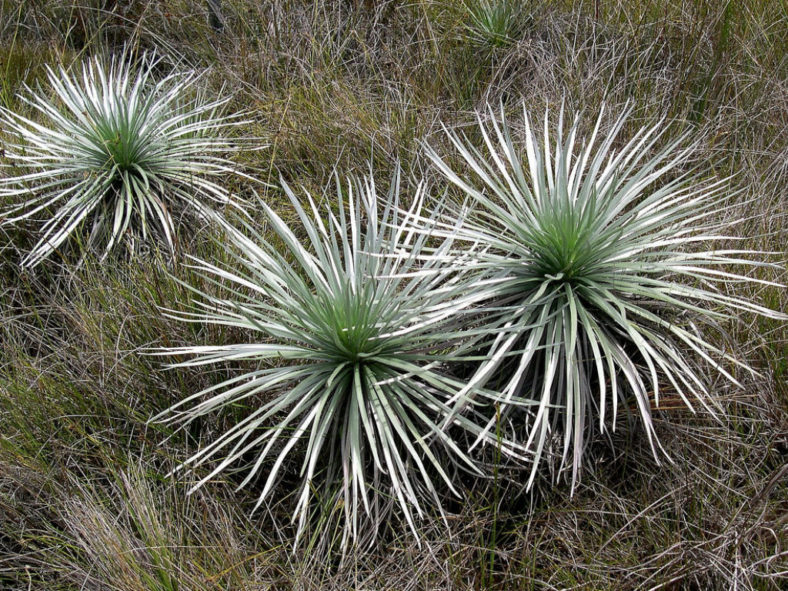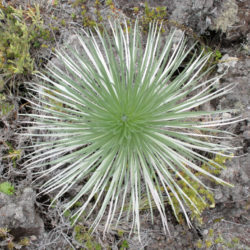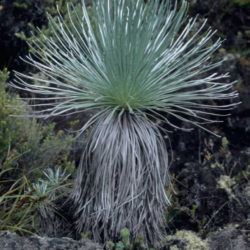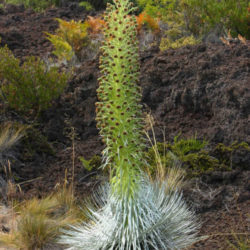Scientific Name
Argyroxiphium kauense (Rock & Neal) O.Deg. & I.Deg.
Common Name(s)
Ka'u Silversword, Mauna Loa Silversword
Synonym(s)
Argyroxiphium sandwicense subsp. kauense, Argyroxiphium sandwicense var. kauense, Dubautia kauensis
Scientific Classification
Family: Asteraceae
Subfamily: Asteroideae
Tribe: Madieae
Genus: Argyroxiphium
Origin
This species is endemic to the eastern and southern slopes of Mauna Loa on the island of Hawaii. It occurs in montane shrubland, bogs, and open mesic forest.
Description
Argyroxiphium kauense is an erect rosette shrub with dagger-shaped leaves covered with fine short silvery hairs. It grows up to 4.25 feet (1.3 m) tall and up to 32 inches (80 cm) in diameter, usually single-stemmed or occasionally with few branches. Leaves are triangular in cross section, up to 16 inches (40 cm) long and 0.3 inches (0.7 cm) wide.
In summer, a flowering stalk emerges from the center of the rosette and grows to 6.6 feet (2 m) tall, bearing 100 and 300 flower heads, each with 50 to 200 small, densely clustered flowers. The flowers are pale yellow, yellow with a rose tinge, rose, or sometimes wine-red. Fruits are dry, black, single-seeded, up to 0.4 inches (1 cm) long achenes. This plant is monocarpic, which means it blooms only once in its life, then set fruits and dies.
Etymology
The specific epithet "kauense (kau-EN-see)" refers to the Ka'u district of Hawaii County, Hawaii, where a type specimen originated.

Hardiness
USDA hardiness zone 10a to 10b: from 30 °F (−1.1 °C) to 40 °F (+4.4 °C).
How to Grow and Care
The Silversword alliance is a group of about 50 species of plants belonging to three genera endemic to the Hawaiian islands. They get their common name from the visually impressive Silversword.
Argyroxiphium kauense is endemic to the eastern and southern slopes of Mauna Loa on the island of Hawaiʻi. It occurs in a much broader range of habitats than the closely related and better-known Haleakalā silversword (Argyroxiphium sandwicense subsp. macrocephalum). It is found in montane shrubland, bogs, and open mesic forest.
Although threatened by damage from feral pigs, goats, and mouflon sheep, most of the areas where it currently exists are now protected, and the species is actively managed by the National Park Service and Hawai'i State Department of Forestry and Wildlife. It is a federally listed endangered species of the United States. There are three known occurrences remaining, for a total of fewer than 1000 individuals.
Links
- Back to genus Argyroxiphium
- Succupedia: Browse succulents by Scientific Name, Common Name, Genus, Family, USDA Hardiness Zone, Origin, or cacti by Genus
Photo Gallery
Click on a photo to see a larger version.


